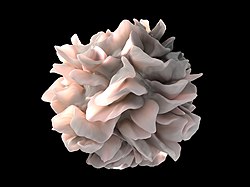Conventional dendritic cell
| Dendritic cell | |
|---|---|

Dendritic cells in skin
|
|

Artistic rendering of the surface of a human dendritic cell illustrating sheet-like processes that fold back onto the membrane surface. When exposed to HIV, some defend that these sheets entrap viruses in the vicinity and focus them to contact zones with T cells targeted for infection. These studies were carried out using ion abrasion scanning electron microscopy, a new technology the NIH has been developing and applying for 3D cellular imaging. Source: Sriram Subramaniam, National Cancer Institute (NCI) and Donny Bliss, National Library of Medicine (NLM).
|
|
| Details | |
| System | Immune system |
| Latin | cellula dendritiformis |
| TH | H1.00.01.0.00038 |
|
Anatomical terminology
[]
|
|
Dendritic cells (DCs) are antigen-presenting cells (also known as accessory cells) of the mammalian immune system. Their main function is to process antigen material and present it on the cell surface to the T cells of the immune system. They act as messengers between the innate and the adaptive immune systems.
Dendritic cells are present in those tissues that are in contact with the external environment, such as the skin (where there is a specialized dendritic cell type called the Langerhans cell) and the inner lining of the nose, lungs, stomach and intestines. They can also be found in an immature state in the blood. Once activated, they migrate to the lymph nodes where they interact with T cells and B cells to initiate and shape the adaptive immune response. At certain development stages they grow branched projections, the dendrites that give the cell its name (δένδρον or déndron being Greek for "tree"). While similar in appearance, these are structures distinct from the dendrites of neurons. Immature dendritic cells are also called veiled cells, as they possess large cytoplasmic 'veils' rather than dendrites.
Dendritic cells were first described by Paul Langerhans (hence "Langerhans cells") in the late nineteenth century. The term "dendritic cells" was coined in 1973 by Ralph M. Steinman and Zanvil A. Cohn. For discovering the central role of dendritic cells in the adaptive immune response, Steinman was awarded the Albert Lasker Award for Basic Medical Research in 2007 and the Nobel Prize in Physiology or Medicine in 2011.
...
Wikipedia
